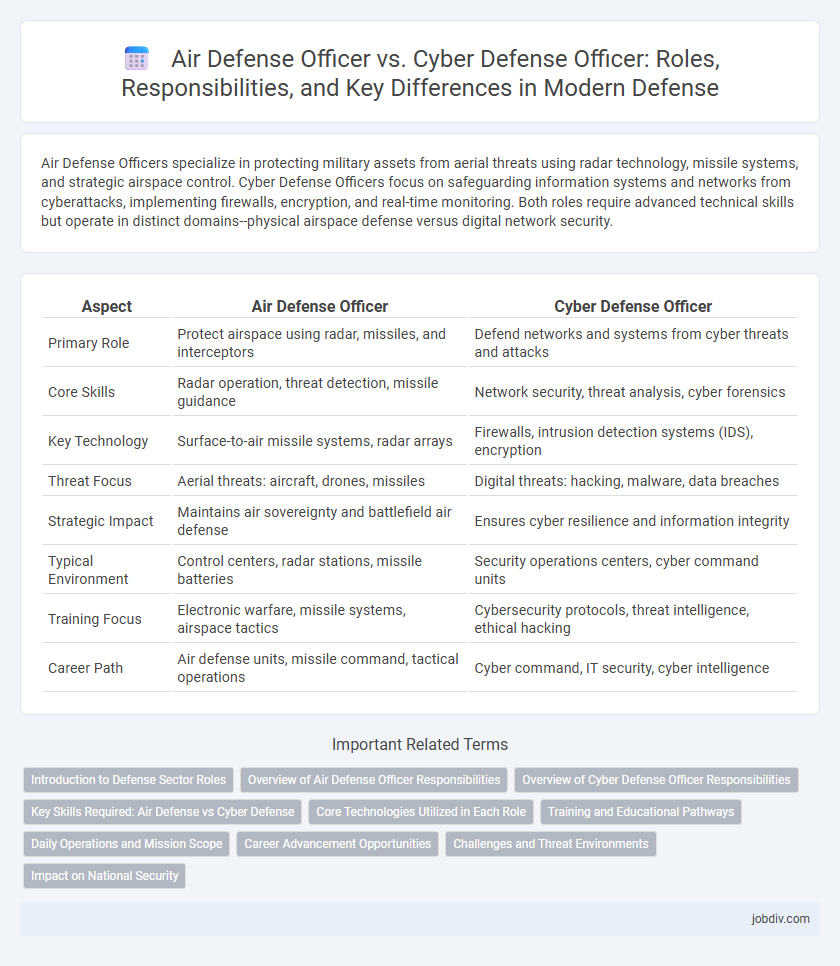Air Defense Officers specialize in protecting military assets from aerial threats using radar technology, missile systems, and strategic airspace control. Cyber Defense Officers focus on safeguarding information systems and networks from cyberattacks, implementing firewalls, encryption, and real-time monitoring. Both roles require advanced technical skills but operate in distinct domains--physical airspace defense versus digital network security.
Table of Comparison
| Aspect | Air Defense Officer | Cyber Defense Officer |
|---|---|---|
| Primary Role | Protect airspace using radar, missiles, and interceptors | Defend networks and systems from cyber threats and attacks |
| Core Skills | Radar operation, threat detection, missile guidance | Network security, threat analysis, cyber forensics |
| Key Technology | Surface-to-air missile systems, radar arrays | Firewalls, intrusion detection systems (IDS), encryption |
| Threat Focus | Aerial threats: aircraft, drones, missiles | Digital threats: hacking, malware, data breaches |
| Strategic Impact | Maintains air sovereignty and battlefield air defense | Ensures cyber resilience and information integrity |
| Typical Environment | Control centers, radar stations, missile batteries | Security operations centers, cyber command units |
| Training Focus | Electronic warfare, missile systems, airspace tactics | Cybersecurity protocols, threat intelligence, ethical hacking |
| Career Path | Air defense units, missile command, tactical operations | Cyber command, IT security, cyber intelligence |
Introduction to Defense Sector Roles
Air Defense Officers specialize in protecting national airspace through radar monitoring, missile systems, and aircraft coordination to counter aerial threats. Cyber Defense Officers focus on safeguarding defense networks from cyberattacks, managing threat intelligence, and implementing cybersecurity protocols to secure sensitive military data. Both roles are critical in modern defense strategies, blending physical and digital security to maintain operational integrity.
Overview of Air Defense Officer Responsibilities
Air Defense Officers coordinate and manage integrated air defense systems to detect, track, and neutralize aerial threats using radar, missile systems, and anti-aircraft artillery. Their responsibilities include tactical planning, threat assessment, and maintaining readiness of air defense units to protect critical infrastructure and military assets from hostile aircraft and missiles. They collaborate closely with intelligence, communication, and command units to ensure seamless airspace security and rapid response during combat operations.
Overview of Cyber Defense Officer Responsibilities
Cyber Defense Officers are responsible for protecting military networks and critical infrastructure from cyber threats through continuous monitoring, threat analysis, and incident response. They develop and implement cybersecurity protocols, conduct vulnerability assessments, and coordinate with intelligence units to mitigate cyberattacks targeting defense systems. Their role also includes training personnel in cyber hygiene and ensuring compliance with cybersecurity policies to maintain mission readiness.
Key Skills Required: Air Defense vs Cyber Defense
Air Defense Officers require expertise in radar systems, missile technology, and real-time threat assessment to effectively manage aerial threats and coordinate with ground forces. Cyber Defense Officers must possess advanced knowledge in network security, intrusion detection, cryptography, and cyber threat intelligence to protect critical military infrastructure against digital attacks. Both roles demand strong analytical skills and rapid decision-making under pressure, yet Air Defense emphasizes physical threat interception, while Cyber Defense prioritizes safeguarding information systems.
Core Technologies Utilized in Each Role
Air Defense Officers primarily utilize radar systems, missile guidance technology, and early warning detection systems to monitor and neutralize aerial threats. Cyber Defense Officers focus on advanced encryption protocols, intrusion detection systems, and cybersecurity frameworks to protect network infrastructure from cyberattacks. Both roles leverage specialized software platforms and real-time data analytics to enhance situational awareness and response efficiency.
Training and Educational Pathways
Air Defense Officers typically undergo rigorous training in radar systems, missile technology, and tactical airspace management, often attending specialized military academies or defense institutions with a focus on aerospace and electronic warfare. Cyber Defense Officers require comprehensive education in computer science, network security, and cyber threat analysis, frequently obtaining degrees in cybersecurity or information technology combined with certifications such as CISSP or CEH. Both pathways emphasize continuous professional development, but Air Defense centers on real-time physical threat interception while Cyber Defense prioritizes safeguarding digital infrastructure against cyberattacks.
Daily Operations and Mission Scope
Air Defense Officers manage radar systems, missile batteries, and coordinate airborne threat interceptions, ensuring physical airspace security through real-time threat detection and engagement. Cyber Defense Officers focus on safeguarding digital infrastructure by monitoring network traffic, identifying cyber intrusions, and executing incident response to protect critical information systems from cyberattacks. While Air Defense missions prioritize kinetic neutralization of airborne threats, Cyber Defense operations emphasize preventing, detecting, and mitigating cyber threats against military communication and command networks.
Career Advancement Opportunities
Air Defense Officers often advance through tactical command roles and strategic air operations leadership, gaining expertise in missile systems and radar technology management. Cyber Defense Officers progress by developing advanced skills in network security, threat analysis, and cyber warfare strategy, often moving into higher positions within cybersecurity command centers or defense cyber agencies. Both career paths offer opportunities for specialization and leadership, but Cyber Defense Officers typically experience faster growth due to the increasing importance of cyber warfare in national security.
Challenges and Threat Environments
Air Defense Officers face challenges tied to detecting and neutralizing aerial threats such as missiles, drones, and enemy aircraft within highly dynamic and physically constrained environments. Cyber Defense Officers combat sophisticated, persistent cyber threats targeting critical defense networks, requiring expertise in threat intelligence, malware analysis, and incident response amid constantly evolving attack vectors. Both roles demand rapid decision-making under pressure but differ significantly in operational domains--airspace versus cyberspace--each with unique threat landscapes and technological complexities.
Impact on National Security
Air Defense Officers play a critical role in protecting a nation's airspace by managing radar systems, missile defense, and coordinating aircraft interception to prevent aerial threats. Cyber Defense Officers safeguard national security by defending government networks, critical infrastructure, and communication systems against cyberattacks and espionage. Both positions are essential for a comprehensive defense strategy, with Air Defense Officers focusing on physical threats and Cyber Defense Officers addressing digital vulnerabilities that could compromise military and civilian operations.
Air Defense Officer vs Cyber Defense Officer Infographic

 jobdiv.com
jobdiv.com